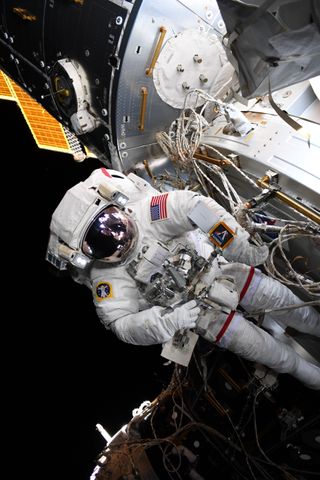 The launch was initially planned for 2007.Getty
The launch was initially planned for 2007.Getty
- NASA's $10 billion successor to the Hubble Space Telescope has finally been fully assembled, after 12 years of delays and cost overruns.
- The two halves that make up the next-generation space telescope have been brought together by NASA engineers for the very first time.
- The tennis-court-sized James Webb Space Telescope will be able to see seven times further than the Hubble Space Telescope, capturing more concise pictures of the deep universe.
- Visit Business Insider's homepage for more stories.
After 12 years of delays and cost overruns, the $9.7 billion successor to the Hubble Space Telescope — the James Webb Space Telescope — has finally been fully assembled.
The two halves that make up the next-generation space telescope have been brought together by NASA engineers for the very first time, something which took many years and countless hours of planning to achieve.
"This is an exciting time to now see all Webb's parts finally joined together into a single observatory for the very first time," said Gregory Robinson, the Webb program director at NASA.
"The engineering team has accomplished a huge step forward and soon we will be able to see incredible new views of our amazing Universe."
The telescope will "explore the cosmos using infrared light, from planets and moons within our solar system", according to the NASA press release. It will be able to take very precise pictures of the deep universe, something which only the Hubble Space Telescope was able to achieve before. The Hubble Space Telescope was launched into Earth's orbit in 1990 and remains in operation.
The James Webb Space Telescope is not a replacement for the Hubble Space Telescope, but an upgrade. While Hubble captures optical and ultraviolet wavelengths, James Webb will capture the universe in infrared. It will also be able to look even deeper into the universe.
While Hubble's 7-foot-wide mirror is limited in the amount of light that it can capture, the James Webb Space Telescope has a 21-foot-wide mirror that can see seven times as far.
 NASA engineers are still working on putting in a five-layer sun shield to protect the telescope from the infrared light coming from the Sun.Getty
NASA engineers are still working on putting in a five-layer sun shield to protect the telescope from the infrared light coming from the Sun.Getty
As of now, the telescope has only been connected "mechanically", according to NASA. Engineers working for the space agency still have to connect the wires and links within the telescope for it to be fully functional.
Read more: Trump's NASA chief, who has no scientific background, says Pluto is a planet
The next step for engineers at NASA is to put together the James Webb Space Telescope's five-layer sun shield. The sun shield is an integral part of the telescope since it will protect the telescope's mirrors and scientific instruments from the infrared light coming from the Sun.
James Webb is the size of a tennis court and will only work once it unfurls itself in space without tearing or falling apart — a feat it has yet to accomplish.
"The more we learn more about our universe, the more we realize that Webb is critical to answering questions we didn't even know how to ask when the spacecraft was first designed," said Thomas Zurbuchen, associate administrator for NASA's Science Mission Directorate, in a statement last month.
Den Originalartikel gibt es auf Business Insider India. Copyright 2019. Und ihr könnt Business Insider India auf Twitter folgen.
https://www.businessinsider.com/nasas-ten-billion-dollar-telescope-built-after-decade-of-delays
2019-08-31 07:06:45Z
CBMiX2h0dHBzOi8vd3d3LmJ1c2luZXNzaW5zaWRlci5jb20vbmFzYXMtdGVuLWJpbGxpb24tZG9sbGFyLXRlbGVzY29wZS1idWlsdC1hZnRlci1kZWNhZGUtb2YtZGVsYXlz0gFfaHR0cHM6Ly9hbXAuYnVzaW5lc3NpbnNpZGVyLmNvbS9uYXNhcy10ZW4tYmlsbGlvbi1kb2xsYXItdGVsZXNjb3BlLWJ1aWx0LWFmdGVyLWRlY2FkZS1vZi1kZWxheXM
















